4.3.2: Soils
- Page ID
- 32006
Learning Objectives
- Identify and describe each component of soil.
- Distinguish among sand, silt, and clay and explain how particle size influences water holding capacity and soil texture.
- Describe each horizon in a typical soil profile.
- Explain how soils are formed, describing each of the five major factors that affects soil formation and composition.
- Explain what determines soil pH and how soil pH affects nutrient absorption by plants.
Plants obtain mineral nutrients from the soil, which serves as a natural medium for land plants. Soil is the outer loose layer that covers the surface of Earth. Soil quality is a major determinant, along with climate, of plant distribution and growth. Soil quality depends not only on the chemical composition of the soil, but also on climate, topography, and organisms living in the soil. In agriculture, the history of the soil, such as the cultivating practices and previous crops, modifies the characteristics and fertility of that soil.
Soil Composition
Soil consists of organic matter (about 5%), inorganic mineral matter (40-45% of soil volume), and water (about 25%) and air (about 25%). The amount of each of the four major components of soil depends on the amount of vegetation, soil compaction, and water present in the soil.
The organic material consists of dead organisms in various stages of decomposition. It is dark-colored because it contains humus, partially decayed matter containing organic acids. Humus enriches the soil with nutrients, gives the soil a loose texture that holds water, and allows air to diffuse through it. Oxygen is essential to permit cellular respiration in plant roots, decay organisms, and other inhabitants of the soil. The organic component of soil serves as a cementing agent, returns nutrients to the plant, allows soil to store moisture, makes soil tillable for farming, and provides energy for soil microorganisms. Most soil microorganisms—bacteria, algae, or fungi—are dormant in dry soil, but become active once moisture is available.
The inorganic material of soil consists of rock, slowly broken down into smaller particles that vary in size. Soil particles that are 100 μm to 2 mm in diameter are sand. (A micrometer, μm, 10-6 m, or a millionth of a meter.) Soil particles between 2 and 100 μm are called silt, and even smaller particles, less than 2 μm in diameter, are called clay.
Soil should ideally contain 50 percent solid material and 50 percent pore space (Figure \(\PageIndex{1}\)). Pore space refers to the gaps in between soil particles. The larger the soil particles, the larger the pore spaces. Water can quickly pass through large pore spaces, so soils high in sand drain easily. Smaller soil particles have more surface area relative to volume and produce narrow pore spaces. Water clings to these surfaces, and soils high in clay thus retain water. (Clay is also negatively charged, which attracts water.) About one-half of the pore space should contain water, and the other half should contain air.

Water holding capacity is a measure of of the soils ability to retain water. Technically, it is the field capacity minus the permanent wilting percentage. The field capacity is the percentage of water retained by the soil after excess water is allowed the drain. The permanent wilting percentage (permanent wilting point) is the amount of water left in the soil once the plants have fatally wilted. This measures the amount of water stored in the soil that is actually available to plants.
Soils texture is based on percentages of sand, silt, and clay (Figure \(\PageIndex{2}\)). Soils that have a high percentage of one particle size are named after that particle (a clay soil has a high percentage of clay). Other soils have a mixture of two particle sizes and very little of the third size. For example, silty clay has roughly 50% clay and 50% silt while sandy clay has 50-60% sand and 35-50% clay. Some soils have no dominant particle size and contain a mixture of sand, silt, and humus. These soils are called loams, and they are optimal for agriculture. A medium loam has roughly 40% sand, 40% silt, and 20% clay. Larger particles (sand) facilitate drainage, and small particles (clay) facilitate water retention, so loam soils both have good drainage and can remain moist. Medium loams have a water holding capacity of approximately 35%. Soils that deviate slightly from a medium loam include loamy sand, sandy loam, sandy clay loam, clay loam, silty clay loam, and silty loam.
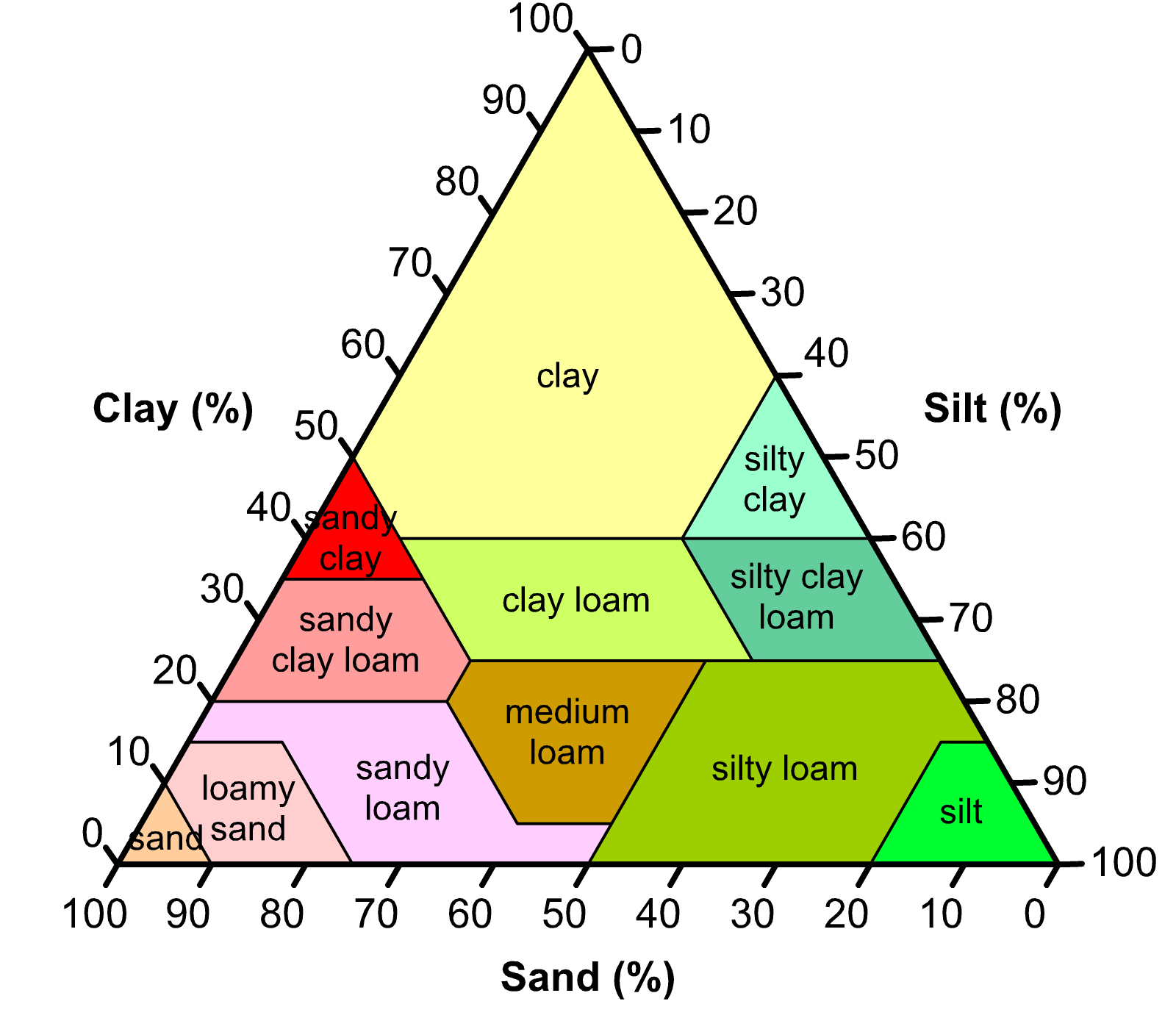
Organic Versus Mineral Soils
Soils can be divided into two groups based on how they form. Organic soils are those that are formed from sedimentation and often contain more than 30% organic matter. They form when organic matter, such as leaf litter, is deposited more quickly than it can be decomposed (Figure \(\PageIndex{3}\)). Mineral soils are formed from the weathering of rocks, typically contain no more than 30% organic matter, and are primarily composed of inorganic material. Weathering occurs when biological, physical, and chemical processes, such as erosion, leaching, or high temperatures, break down rocks.
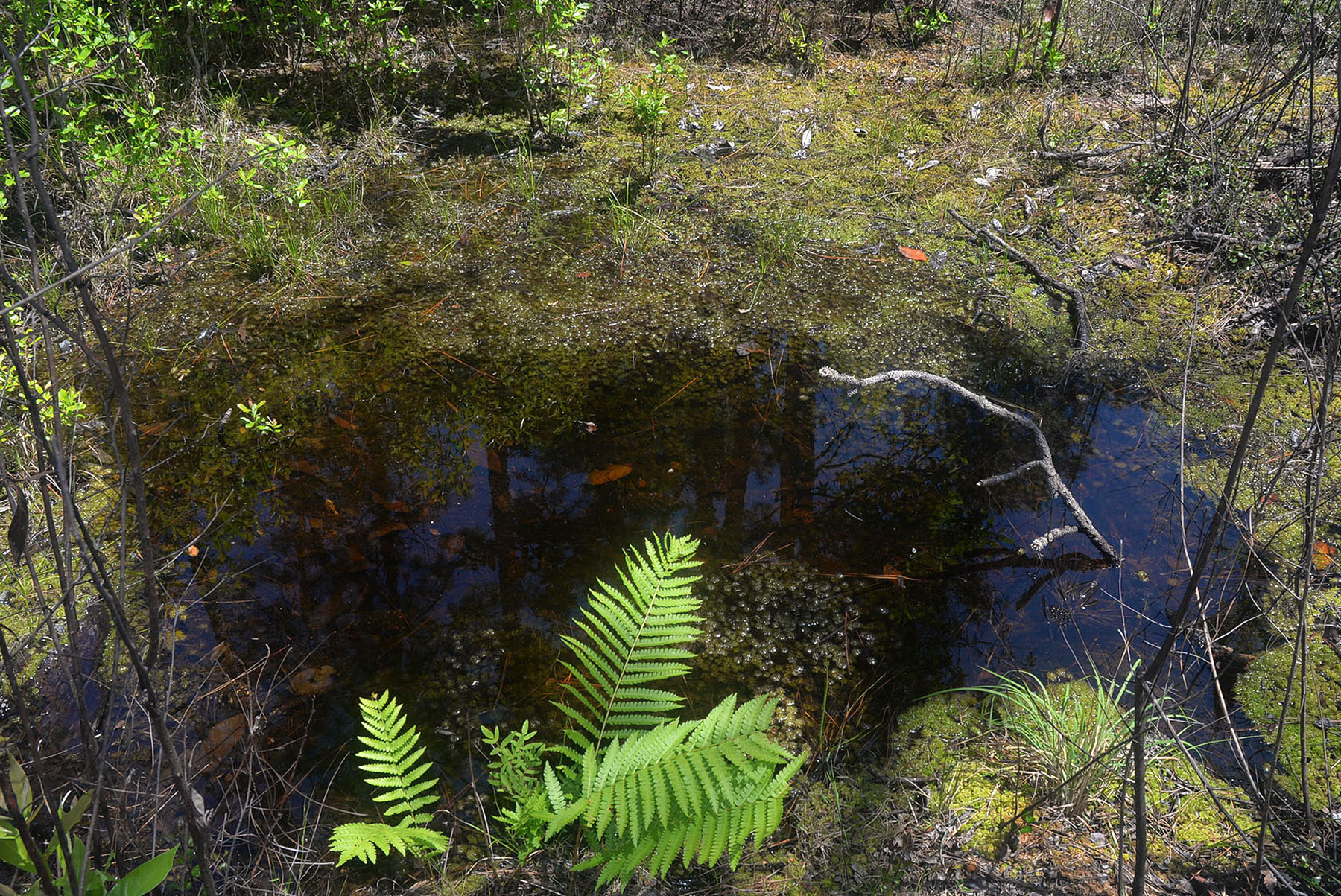
Soil Horizons
Soil distribution is not homogenous because its formation results in the production of layers; together, the vertical section of a soil is called the soil profile. Within the soil profile, soil scientists define zones called horizons. A horizon is a soil layer with distinct physical and chemical properties that differ from those of other layers.
The typical soil profile has four distinct layers: 1) O horizon; 2) A horizon; 3) B horizon and 4) C horizon (Figure \(\PageIndex{4}\)). Some soils may have additional layers or lack one of these layers. The thickness of the layers is also variable, and depends on the factors that influence soil formation. In general, immature soils may have O, A, and C horizons, whereas mature soils may display all of these, plus additional layers.
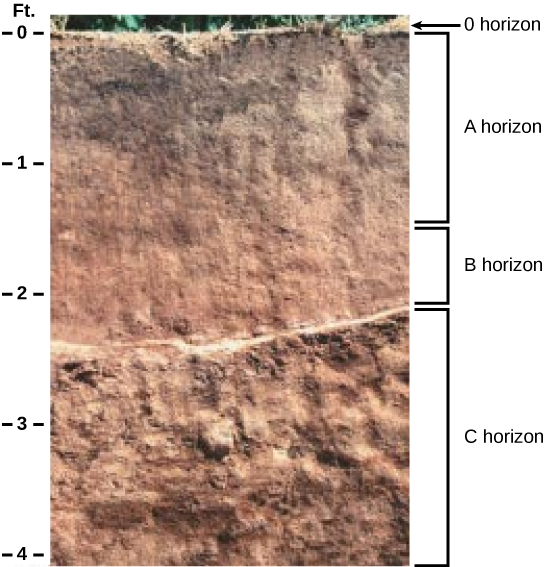
O horizon
The very top of the O horizon (organic layer) consists of partially decayed organic debris like leaves. This horizon is usually dark in color because of humus.
A horizon
The A horizon (topsoil) consists of a mixture of organic material with inorganic products of weathering, and it is therefore the beginning of true mineral soil. In this area, rainwater percolates through the soil and carries materials from the surface. The A horizon may be only 5 cm (2 in.), or it may over a meter. For instance, river deltas like the Mississippi River delta have deep layers of topsoil. Microbial processes occur in the top soil, and this horizon supports plant growth. Many organisms, such as earthworms and insects, live among the plant roots in this horizon.
B horizon
The B horizon (subsoil) consists of small particles that have moved downward, resulting in a dense layer in the soil. In some soils, the B horizon contains nodules or a layer of calcium carbonate. The subsoil is usually lighter in color that topsoil and often contains an accumulation of minerals.
C horizon
The C horizon (soil base), includes the parent material, the organic and inorganic substances from which soils form. Weathering parent material represents the first steps in the chemical breakdown of rock into soil. Often the weathered parent material is underlain by the parent material itself, although in some places it has been carried from another location by wind, water, or glaciers. Beneath the C horizon lies bedrock. The chemical nature of the parent material, whether granite, limestone, or sandstone, for example, has a great influence on the fertility of the soil derived from it.
Factors Affecting Soil Formation and Composition
The fundamental factors that affect soil genesis can be categorized into five elements: climate, organisms, topography (or relief), parent material, and time. One could say that the relief, climate, and organisms dictate the local soil environment and act together to cause weathering and mixing of the soil parent material over time.
Climate
The role of climate in soil development includes aspects of temperature and precipitation. Soils in very cold areas with permafrost conditions (such as the Arctic tundra) tend to be shallow and weakly developed due to the short growing season. In warm, tropical climates, soils tend to be thicker (but lacking in organic matter), with extensive leaching and mineral alteration due to heavy precipitation. In such climates, organic matter decomposition and chemical weathering occur at an accelerated rate. The presence of moisture and nutrients from weathering will also promote biological activity: a key component of a quality soil. The soils of four biomes are described below as examples of the effects of climate on soil composition.
Tropical Rainforests
The lushness of the jungle biome is somewhat illusory. While productivity is high, the soils themselves tend to be of very poor quality (Figure \(\PageIndex{5}\)). Because of the high rainfall, nutrients are quickly washed out of the topsoil unless they are incorporated in the forest plants. As plant and animal debris falls to the ground, it is quickly decomposed because of the warmth and moisture there. Thus minerals are found mainly in the forest plants, not in the soil. When the plants are removed and cultivation attempted, the soils quickly lose fertility. The situation is made worse by the lack of humus. Additionally, the topsoil may be no thicker than 5 cm (~2 inches), and most of these soils have high iron and aluminum content. Once exposed to the sun, these soils quickly bake into a brick-like material that cannot be cultivated.

Temperate Forests
These regions receive 75–100 cm (~30-39") or more of precipitation each year. Enough water falls on the soil so that much of it passes down to the water table. As it does so, it carries minerals with it. Such soils tend to be acidic and of low and (if unattended) diminishing fertility when used for agriculture. Only by regular fertilization and liming (to restore calcium and raise pH) can productive agriculture be carried out in them. In the U.S., the soils east of the Appalachian Mountains tend to be of this sort (Figure \(\PageIndex{6}\)).
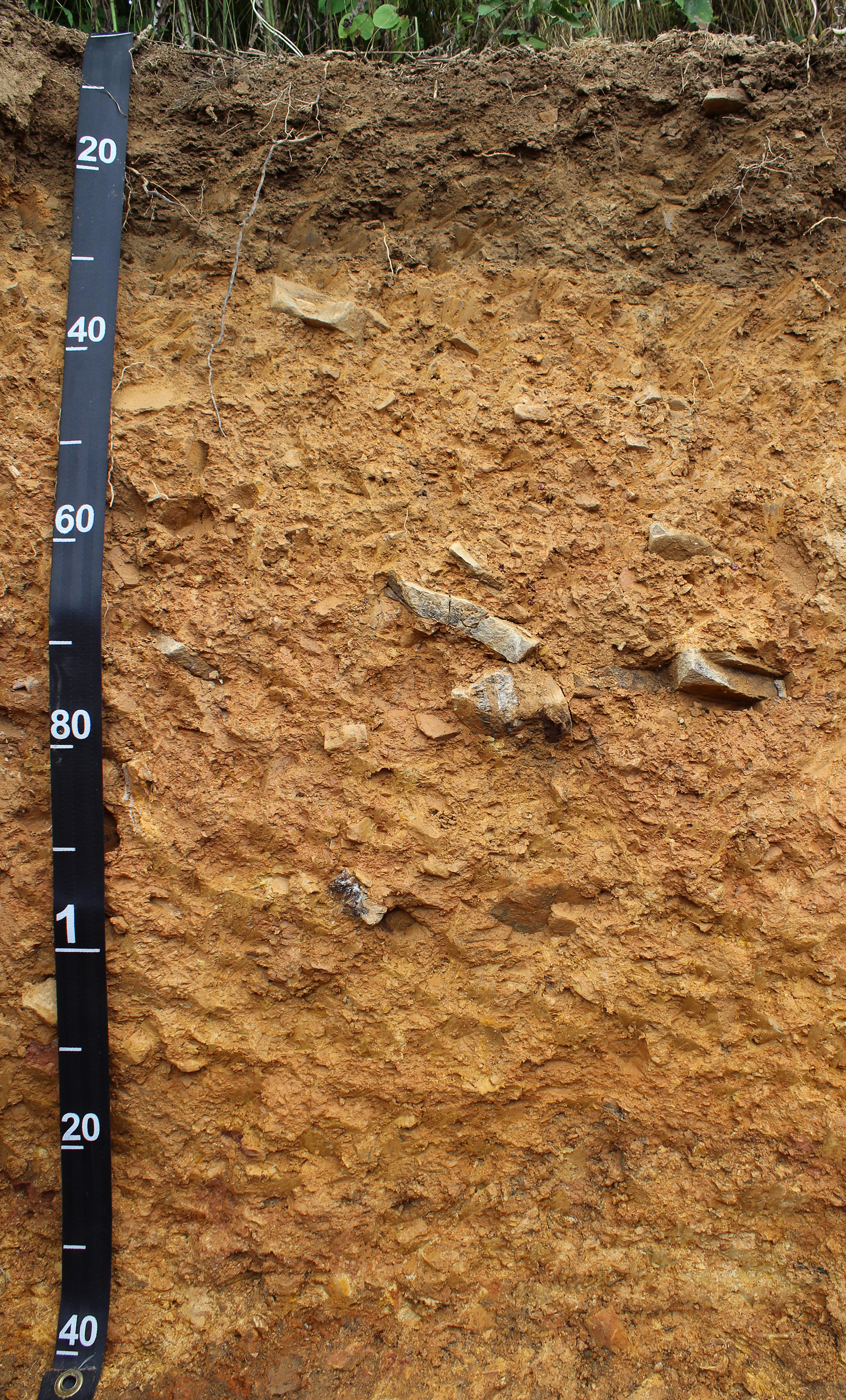
Temperate Grasslands
In the plains of North America, the annual rainfall is sufficiently low (~50 cm, 20") that little or no rainfall percolates down to the water table. Calcium and other minerals are not carried below the reach of plant roots and so remain available for use. This keeps the pH and general fertility high (Figure \(\PageIndex{7}\)). Except to the extent that minerals are lost when crops are removed, the minerals simply recycle from subsoil to topsoil and back to the subsoil. The self-restoring fertility of the soils of the plains states accounts for this region being the "breadbasket" of the nation (and other countries as well).
The grasses in undisturbed prairie are perennial. Their extensive root systems help prevent soil erosion, and the return of the season's above-ground growth to the topsoil returns minerals and provides humus to it. These advantages are diminished when annual grasses such as wheat and corn are grown instead and removed in the harvest.
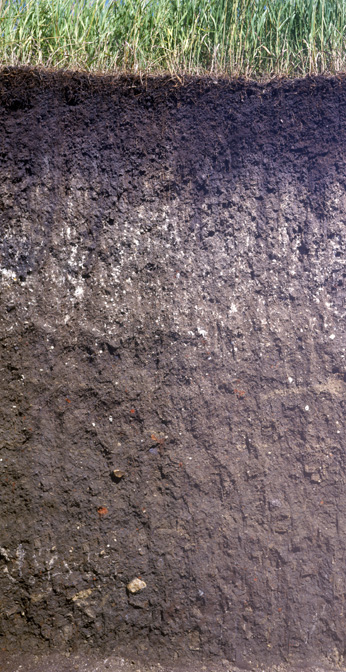
Deserts
The rainfall here is so low, 25 cm (10") per year or less, that any water that does not immediately run off remains near the surface and is largely lost by evaporation. The salts it carries are left near the top of the soil. Their accumulation may make the soil so alkaline and so salty that most crops cannot be grown (Figure \(\PageIndex{8}\)).
In the U. S., the situation is especially severe in the Great Basin because water flowing down from the mountains—bearing its load of dissolved salts—cannot flow on to the ocean but simply flows out onto the valley floors and evaporates. Large areas of formerly unproductive desert in the United States, Israel, and Egypt have been converted into fertile fields through irrigation. However, even the best irrigation water contains dissolved salts. If just enough water is applied to meet the needs of the crop, the salts are never carried deep in the soil. The high rate of evaporation found in these areas hastens the accumulation of salts in the upper layers of the soil. If uncorrected, the condition may become so severe that only salt-tolerant crops, like sugar beets, can be grown.
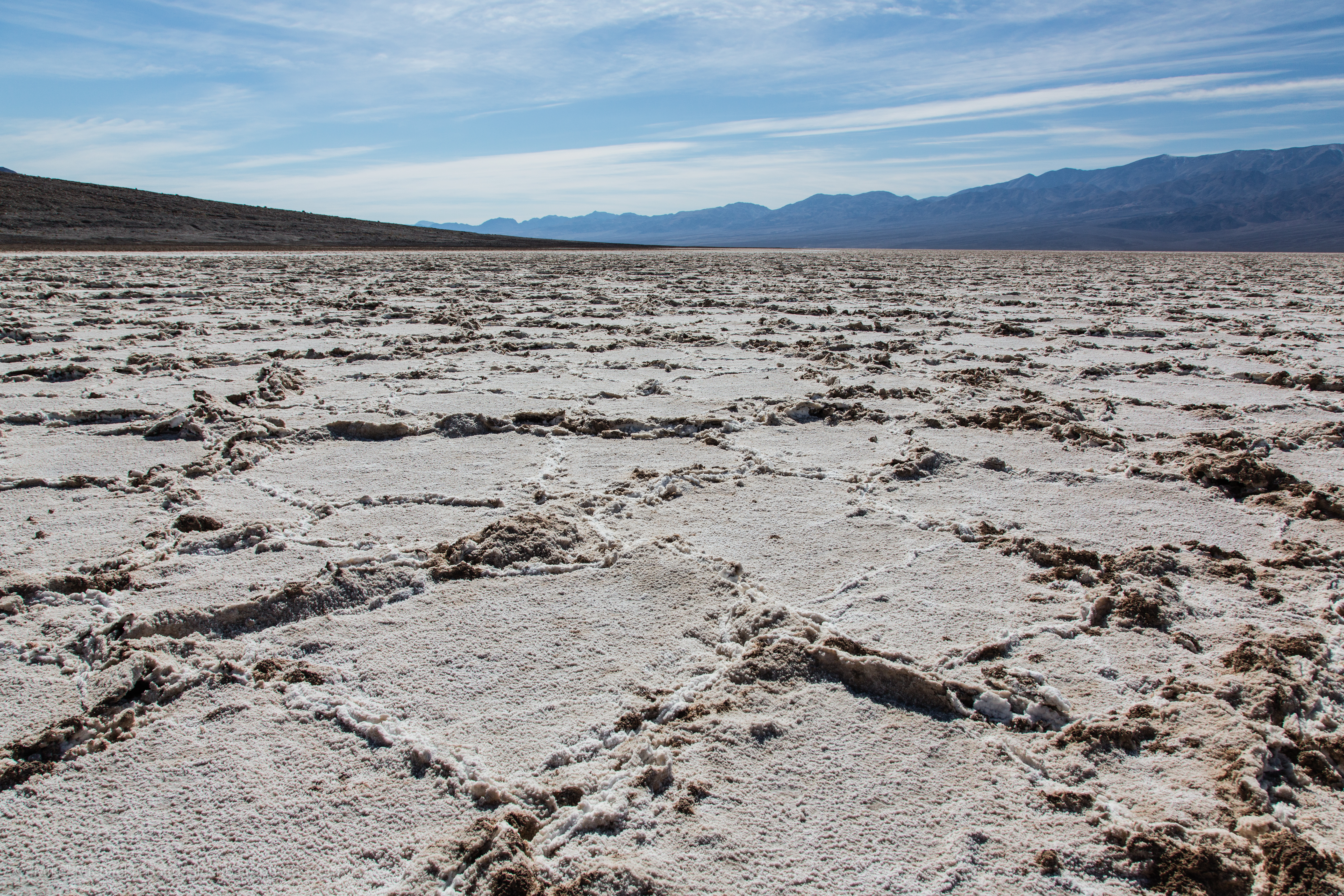
Organisms
The presence of living organisms in the soil (soil biota) greatly affects soil formation and structure. A diversity of animals found in the soil such as nematodes, spiders, insects, centipedes, millipedes, pillbugs, slugs, and earthworms (Figure \(\PageIndex{9}\)). The soil also contains microorganisms like bacteria, archaea, fungi, and "protists". Animals and microorganisms can produce pores and crevices, and plant roots can penetrate into crevices to produce more fragmentation. Plant secretions promote the development of microorganisms around the root, in an area known as the rhizosphere. Through the process of hydraulic redistribution, plants can relocate water in the soil. For example, deep roots can pull water from the lower soil levels and release it at the upper levels. Additionally, leaves and other material that fall from plants decompose and contribute to soil composition. Microorganisms not only decompose organic matter, but contribute to other processes in nutrient cycles, such as nitrogen fixation.

Parent Material
Mineral soils form directly from the weathering of bedrock, the solid rock that lies beneath the soil, and therefore, they have a similar composition to the original rock. Other soils form in materials that came from elsewhere, such as sand and glacial drift. Materials located in the depth of the soil are relatively unchanged compared with the deposited material. Sediments in rivers may have different characteristics, depending on whether the stream moves quickly or slowly. A fast-moving river could have sediments of rocks and sand, whereas a slow-moving river could have fine-textured material, such as clay and silt.
The type of parent material may also affect the rapidity of soil development. Parent materials that are highly weatherable (such as volcanic ash) will transform more quickly into highly developed soils, whereas parent materials that are quartz-rich, for example, will take longer to develop. Parent material also provide nutrients to plants and can affect soil internal drainage.
Topography
Regional surface features (familiarly called “the lay of the land”) can have a major influence on the characteristics and fertility of a soil. Topography affects water runoff, which strips away parent material and affects plant growth. Steeps soils are more prone to erosion and may be thinner than soils that are relatively flat or level. Infiltration, the percolating of water through the soil, is limited in steep soils.
The local topography can have important microclimatic effects. In the northern hemisphere, south-facing slopes are exposed to more direct sunlight angles and are thus warmer and drier than north-facing slopes. The cooler, moister north-facing slopes have a more dynamic plant community due to less evapotranspiration (the combination of liquid water escaping as water vapor and water vapor exiting stomata in plants). They consequently have thicker soils because extensive root systems stabilize the soil and reduce erosion (Figure \(\PageIndex{10}\)).

Soil drainage affects mineral composition and organic matter accumulation. Well-drained soils, generally on hills or sideslopes, are more brownish or reddish due to conversion of ferrous iron (Fe2+) to minerals with ferric (Fe3+) iron. More poorly drained soils in flat areas tend more be more greyish, greenish-grey (gleyed), or dark colored, due to iron reduction (to Fe2+) and accumulation and preservation of organic matter in areas tending towards anoxic. Areas with poor drainage also tend to be lowlands into which soil material may wash and accumulate from surrounding uplands, often resulting in overthickened A or O horizons. In contrast, steeply sloping areas in highlands may experience erosion and have thinner surface horizons
Time
Time is an important factor in soil formation because soils develop over long periods. Soil formation is a dynamic process. Materials are deposited over time, decompose, and transform into other materials that can be used by living organisms or deposited onto the surface of the soil.
In general, soil profiles tend to become thicker (deeper), more developed, and more altered over time. However, the rate of change is greater for soils in youthful stages of development. The degree of soil alteration and deepening slows with time and at some point, after tens or hundreds of thousands of years, may approach an equilibrium condition where erosion and deepening (removals and additions) become balanced. Young soils (< 10,000 years old) are strongly influenced by parent material and typically develop horizons and character rapidly. Over time, as weathering processes deepen, mix, and alter the soil, the parent material becomes less recognizable as chemical, physical, and biological processes take their effect. Moderate age soils (roughly 10,000 to 500,000 years old) are slowing in profile development and deepening, and may begin to approach equilibrium conditions. Old soils (>500,000 years old) have generally reached their limit as far as soil horizonation and physical structure, but may continue to alter chemically or mineralogically.
Soil development is not always continual. Geologic events such as landslides, glacier advance, or the rising of shorelines can rapidly bury soils. Erosions in rivers and shorelines can cause removal or truncation of soils, and wind or flooding slowly deposited sediment that add to the soil. Animals can mix the soil and sometimes cause soil regression, a reversal or "bump in the road" for the normal path of development, and this increases development over time.
Soil pH and Nutrient Availability
Most plants grow well in soils at a pH of 5.5-6.5. These acidic conditions mean that there is a greater proton concentration. Protons can bind to negative soil particles, freeing essential elements that occur as cations in the soil, similar to the mechanism of cation exchange. Additionally, acidic conditions help rocks break down, which adds mineral nutrients to the soil. Some nutrients also dissolve more easily at this pH, making it easier for roots to absorb them. Finally, some cations will precipitate, becoming unavailable to plants, if the soil is alkaline (basic).
Soil pH also indirectly affects nutrient availability by influencing decomposition rates by microorganisms. When conditions are extremely acidic or basic, decomposition is slowed. Even in the pH range that is suitable for decomposition, the microbial community differs depending on pH with fungi becoming more dominant in slightly acidic conditions.
Several factors determine soil pH. Organic material in soil decreases pH to an extent, but it also acts as a buffer, limiting changes in pH. Climate is also important, with high amounts of rainfall increasing leaching and lowering pH. Some types parent material, such as those high in silicon, decrease pH, while others, such as limestone increase pH.
Soil Taxonomy
Soils are classified into one of 12 soil orders based on soil horizons, how they form, and their chemical compositions. For example, Mollisols (Figure \(\PageIndex{7}\)), which are found in temperate grasslands, have a thick topsoil rich in organic content. Aridisols, on the other hand, are dry soils that contain calcium carbonate and are found in deserts. Each soil order is further divided into suborders. See USDA's The Twelve Orders of Soil Taxonomy and The Twelve Soil Orders from the University of Idaho for more details.
Career Connections: Soil Scientist
A soil scientist studies the biological components, physical and chemical properties, distribution, formation, and morphology of soils (Figure \(\PageIndex{11}\)). Soil scientists need to have a strong background in physical and life sciences, plus a foundation in mathematics. They may work for federal or state agencies, academia, or the private sector. Their work may involve collecting data, carrying out research, interpreting results, inspecting soils, conducting soil surveys, and recommending soil management programs.
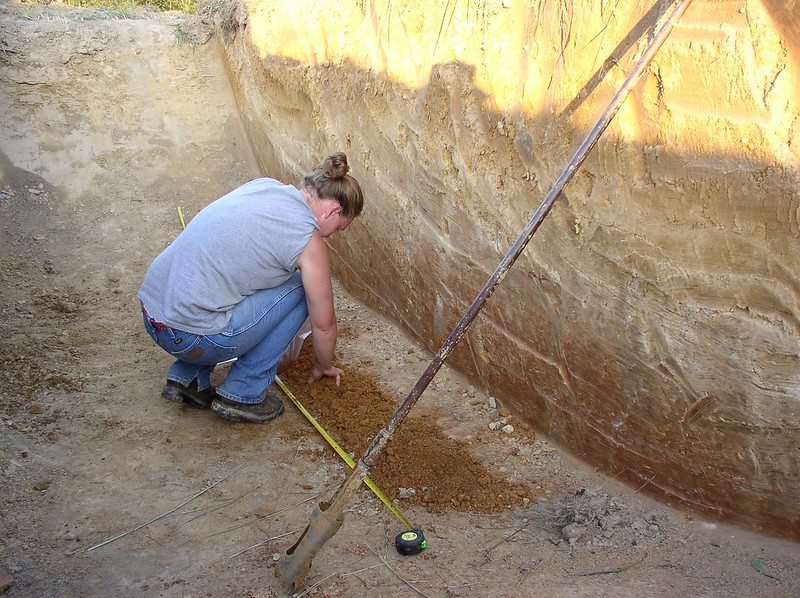
Many soil scientists work both in an office and in the field. According to the United States Department of Agriculture (USDA), "A soil scientist needs good observation skills to be able to analyze and determine the characteristics of different types of soils. Soil types are complex and the geographical areas a soil scientist may survey are varied. Aerial photos or various satellite images are often used to research the areas. Computer skills and geographic information systems help the scientist to analyze the multiple facets of geomorphology, topography, vegetation, and climate to discover the patterns left on the landscape.” Soil scientists play a key role in understanding the soil’s past, analyzing present conditions, and making recommendations for future soil-related practices.
References
Careers in Soil Science. National Resources Conservation Service / United States Department of Agriculture. Accessed 2020-08-05.
Attributions
Curated and authored by Melissa Ha using the following sources:
- 31.2 The Soil from Biology 2e by OpenStax (CC-BY). Access for free at openstax.org.
- 17.2D Soil from Biology by John W. Kimball (CC-BY)
- 9.1 Soil Profiles and Processes from Environmental Biology by Matthew R. Fisher (licensed under CC-BY)


